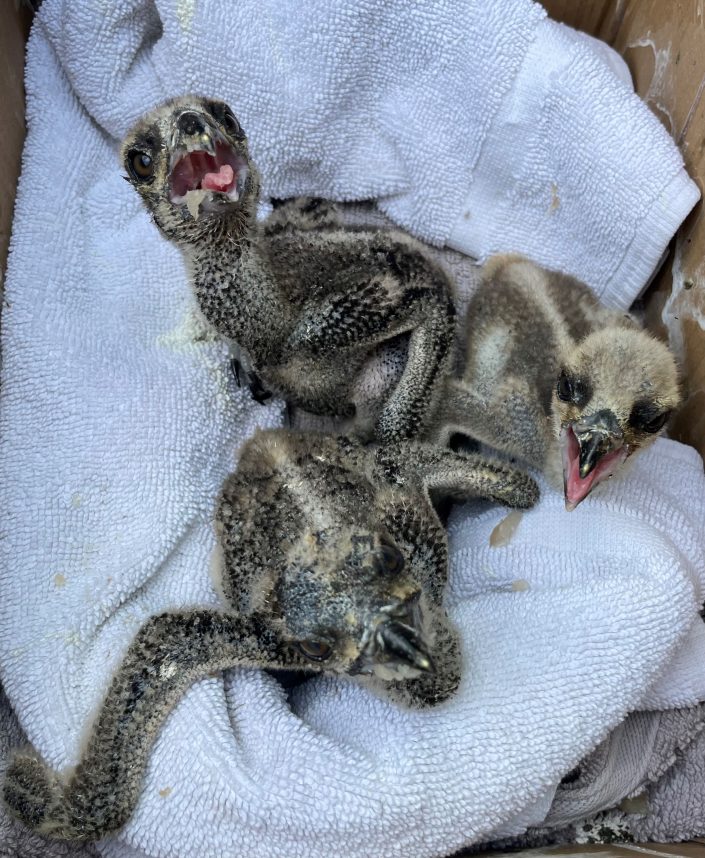Orphaned Osprey Chicks Find New Homes
by Sherry Tirgrath, Wildlife Biologist
Three young osprey chicks found themselves without their parents after a utility pole nest caught fire at the National Guard Training Center (NGTC) in Sea Girt, NJ. Osprey often choose utility poles as nesting structures because of the 360° view they offer. Fires caused by the nests, composed mostly of dried sticks and seagrass, aren’t uncommon. Because of the safety hazard imposed by the nest, it was removed from the utility pole at the NGTC with three healthy chicks inside. The chicks were approximately a week to ten days old when removed from the nest and were brought temporarily to The Raptor Trust in Millington by Charles Appleby, Chief of the Environmental Bureau of the NJ Department of Military and Veterans Affairs (NJDMAVA) to be cared for while a new nesting platform could be built. Reuniting the chicks with their parents in a safe nest box would give them their best chance at survival.


Staff from the NJDMAVA Environmental Bureau, VHB, Inc., (NJDMAVA’s natural resources implementation services consultant and Conserve Wildlife Foundation of NJ (CWF) consulting partner at the NGTC), and the NGTC maintenance section quickly got to work preparing a new nest box for the chicks, installing it on a bare utility post and building a nest inside that was move-in ready for the birds. CWF biologist, Sherry Tirgrath, was tasked with transporting the chicks and monitoring the reunification process. The chicks were placed in the new nest and the parents given time to find the chicks and reclaim them. However, the attempt to reunite was not a success. Both parents approached the nest and observed the chicks but did not land on it. Osprey can be fickle about accepting new nests and the welfare of the chicks was at stake between approaching storms and hungry crows. After multiple attempts to bring the parents to the nest, a decision was made to remove the chicks and bring them back to The Raptor Trust. A new mission plan was developed to find foster nests with similarly aged chicks to place the NGTC chicks in.
Raptor biologist, Ben Wurst of CWF, and his osprey monitoring team survey over 600 osprey nests throughout NJ during the nesting season. Ben took the initiative to find nests with similarly aged chicks to foster the NGTC brood. After some searching, Ben and his team were able to locate two potential foster nests in the Barnegat Bay, each with only one chick. The next step was to recover the NGTC chicks from The Raptor Trust and ship them out to the foster nests. Ben boated a small crew including staff from VHB, Inc. into the Barnegat Bay to assist with the foster process. The brood was divided up so that two chicks were placed into one foster nest and one into the other. Some provisions, a couple of whole menhaden, were also placed in the nest to offset the work the parents would have to do to provide for the now fuller nests. A game camera was affixed to the nest containing three chicks to monitor the brood’s progress remotely. According to the game camera images, the parents returned immediately and began caring for the chicks. So far, all chicks in both nests are doing well and growing nicely.

Photo Courtesy of Jessica Druze (VHB, Inc.)
Since the early 2000’s, the NGTC has hosted two permanent osprey nests and implements a robust natural resources program. One nest is located on a mobile phone cellular tower and the other is on an osprey nest platform built by NJDMAVA Environmental Bureau staff. Both nests fledge between one and four chicks each year and are updated on Osprey Watch (https://www.osprey-watch.org/).
As far as the issue with utility pole nests go at the NGTC, NJDMAVA is exploring humane deterrents to prevent osprey from utilizing the poles as nesting structures. Onsite management is identifying other out-of-service utility poles to host new osprey nest platforms. Utility poles that are favorited by the birds will have deterrent devices installed on them to block nests from being constructed. In the past, osprey have nested and fledged chicks on campus power lines without issue. The nests were removed after the season once they were empty, and the osprey had moved on. However, this year was different due to the volume of rain NJ has been experiencing. The nest that caused the fire was soaked and resulted in a campus-wide power outage. For the safety of the tenants on the NGTC campus, as well as the nesting ospreys, utility pole nests will be discouraged in the future.
Updates on the foster nest chicks are provided on the CWFNJ Facebook and Instagram pages, and will be posted on the blog, as well, at a later date.

Discover more from Conserve Wildlife Foundation of NJ
Subscribe to get the latest posts sent to your email.
Leave a Comment
Kudos to Ben Wurst and his team for rescuing these chicks and re-nesting them.
Kudos to everyone for their contribution to saving these 3 chicks!!!
What a great story with a happy ending for three precious osprey chicks! In a year during which storms and turbid water caused the loss of so many osprey chicks from starvation, it makes me happy to hear about the efforts of all to save these three! Good work!
great news. the osprey bring so much joy to all who see them. their calls are high and always welcome. seeing them fish while you’re sitting on the beach, then seeing fish fly – the very best our world has to offer.
Comments are closed.